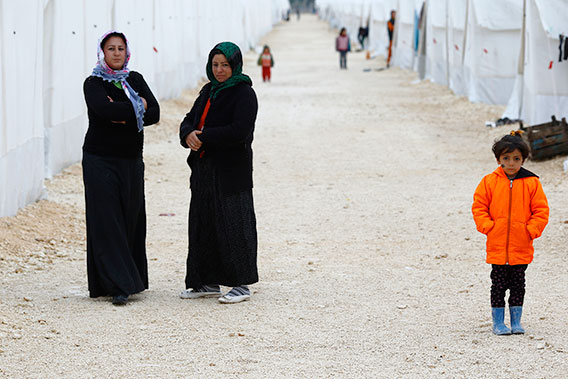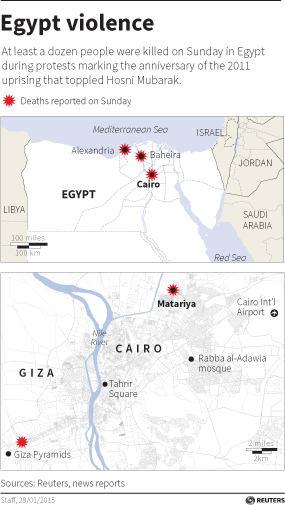ISIS is once again on a rampage. The world learned today that the terror group burned alive the Jordanian pilot on January 3rd by placing him in a cage, dousing him with an inflammable and setting him on fire. Their action has ignited more than ISIS might have bargained for with King Abdullah and the Jordanian people threatening to take revenge on this barbaric act.
This past weekend, ISIS executed a second Japanese hostage, took a minor oil field in Northern Iraq for a few days, stormed the oil-rich city of Kirkuk and intensified the fighting against Iraqi government forces, Shiite militias, Kurdish peshmerga and Sunni tribes. After its outrageous attacks, many observers are struggling to understand the logic – if any – behind ISIS’s deadly acts.
Consider ISIS’s latest moves. On Thursday, ISIS claimed 100 fighters attacked Egyptian army battalion 101, a security site, a military intelligence building, a hotel that hosts army soldiers and security checkpoints in the cities of Arish, Sheikh Zuweid and Rafah in the Sinai Peninsula. It used car bombs filled with 10 tons of explosives, suicide bombers and men with mortars and rocket-propelled grenades. The attacks left 40 soldiers and policemen dead, the heaviest toll since the military coup in June 2013 that overthrew the first elected Islamist civilian president.
Related: ISIS Suffers Heaviest Defeat in Iraq in a Single Day
On Friday, ISIS launched the largest series of attacks in Iraq since last summer. Hundreds of fighters attacked the oil infrastructure to the south of the city of Kirkuk in northern Iraq; Kurdish peshmerga posts near Mosul; Iraqi government posts around the cities of Fallujah, Ramadi and Samarra; and several areas of Baghdad. Car bombs, suicide attackers, mortars and heavy weapons were used in the attacks. A minor oil field to the south of Kirkuk was occupied temporarily and Kirkuk itself was infiltrated before being repelled by the Kurdish resistance. Among others, a Kurdish major general was killed in the attacks. Scores of civilians were slayed as well.

The attacks came on the heels of heavy airstrikes by the U.S. and its allies as if to say, you can’t stop us. CNN reported that the U.S. has killed more than 6,000 ISIS fighters, or a third of an estimated 18,000 jihadist troops. Still, ISIS’ successful recruiting techniques mean they can lure 1,000 foreign fighters every month from overseas.
Despite all the foreign policy and terrorism experts who try to understand ISIS, only a small minority have grasped the inner world of the terror organization and the strategy behind attacks that appear to be, quite literally, all over the map.
Related: 9 ISIS Weapons That Will Shock You
While it often appears that ISIS violence is random – considering the huge amount of attacks, targets and victims — ISIS works, as its predecessor al-Qaeda in Iraq did, with carefully measured strategy and tactics. Understanding the reasons behind ISIS’s attacks is crucial in defeating it.
Several reasons explain the targets and the timing of Friday’s attacks.
Message 1: We Are Still Here
For more than a decade, ISIS and al-Qaeda have targeted Iraq with attacks that mostly serve as saber-rattling. Every time the public thought the terror groups were losing ground, ISIS struck in the deadliest way possible to negate this idea. The message was for both enemies and friends: We are not done yet. We are still strong.
The latest show of force is in response to the series of defeats in Iraq and Syria that ISIS suffered recently. It was just driven out of its last position in Diyala province to the northeast of Baghdad by Shiite militias. Kurdish forces managed to advance to only 10 miles from Mosul in northern Iraq. Dozens of Russian made BM – 21 grade rockets rained in Mosul last week, demonstrating the Kurds’ ability to target the city by short-range missiles. Also, ISIS failed to advance in the western city of Ramadi despite countless attempts. Add to this the heavy defeat in the northern Syrian city of Kobani last week. The message is, ‘We are here and we are still able to launch spectacular attacks that not only inflict death and destruction but also capture more land, cities and Iraqi government military equipment.’
Message 2: We Will Take Revenge
Sectarian favoritism explains ISIS’s targeting of the holy city of Samara, to the north of Baghdad, and Baghdad’s most important commercial area, crowded with Shiite salesmen. Samara’s violence followed shortly after news of a massacre allegedly conducted by Shiite militias in Diyala province in which dozens of Sunni civilians were killed. ISIS’s response was aimed at the Iraqi Sunnis and Muslim Sunnis in general: We are the only ones who can protect you from the Shiite groups and we will take revenge against those who attack you.
Related: Trouble with Our Armed Drones in Yemen
ISIS followed with massive attacks against Kirkuk in the north. Kirkuk is Kurdistan’s Jerusalem, as former Iraqi President Jalal Talbani famously said. The oil in that region could mean a rich independent Kurdistan as opposed to a poor one. The message of these ISIS attacks is mostly aimed at enemies – the Kurds in particular: If you confront us in Mosul and recapture Kobani, we will attack your heart: Kirkuk.

Kurdish refugees from the Syrian town of Kobani. Reuters/Umit Bektas
ISIS and its predecessor al-Qaeda in Iraq have specialized in exploiting ethnic crises, another war-making strategy. Because Kirkuk is in the heart of the ethnically disputed territories in Iraq, Kurds, Arabs and Turkmen are all struggling to control the oil-rich city. This struggle came to a head in June 2014, when Kurdish forces came to control the city after the collapse of the Iraqi army in the north, in the wake of Mosul’s fall to ISIS.
In the Kirkuk attack, ISIS repeated what it did when it attacked Erbil in August 2014 by employing Kurdish fighters who joined it when the Kurdish extremist group Ansar al-Islam pledged allegiance to ISIS in August 2014. This time ISIS played on Kurdish internal disputes.
Another issue ISIS is trying to exploit is the anger of Iraqi Sunnis (who were displaced from their cities after ISIS emerged last summer) towards Kurdistan for closing its borders in their faces. Just like Lebanon, Jordan and Turkey, Kurdistan was flooded with hundreds of thousands of refugees from the twin conflicts of Syria and Iraq. After the bombings in Erbil late September 2014, the Kurdish authorities started to restrict the entrance of more refugees because of security concerns. The very areas to the south of Kirkuk where the latest ISIS attacks took place are where the Sunni Arab refugees were stopped by the Kurds. “More than 500 families are spending their nights in the streets after the Kurdish authorities prevented them entry to Kurdistan via Kirkuk. A child died of cold weather,” said Nazal al-Jbara, a tribal sheikh of al-Joubur tribe.

The attacks in the Sinai were meant to convey a similar message. Egypt just celebrated the fourth anniversary of the January 25th Revolution, an uprising that was initiated and led by liberal youth using nonviolent means. ISIS’s attacks against the Egyptian army, which has since taken power by overthrowing an elected Muslim Brotherhood government, were a way to demonstrate the strength of ISIS’s bid for power, which purposefully excludes the chivalry of nonviolence and elections.
ISIS’s attacks convey the promise to take revenge for the underdog, despite an inconsistency in political theory and tactic. Weeks ago, the former dictator Hosni Mubarak was found innocent of wrongdoing by an Egyptian court. Days earlier, his two sons were freed after a similar court decision. By killing army soldiers and police, ISIS’s message is that their version of justice is more reliable than the Egyptian judiciary’s.
Message 3: We Can Trump National and International Systems
Whenever there’s a major political agreement, ISIS doubles down on attacks to douse any optimism among Iraqis and foreigners over Iraq’s future.
The 2015 Iraqi federal budget was passed several days ago. This is the first budget to be passed in more than two years, and it marked the end of a long dispute between the federal government and the Kurdistan region over oil revenues.
By damaging the oil infrastructure in Kirkuk, both the Iraqi government and the Kurds would be denied a vital source of funding for their war against the terror organization. Controlling this infrastructure is no longer an option for ISIS because of the continuous U.S. – led air bombing.
Attacks in Anbar province and around the city of Fallujah in particular were meant to carry a message beyond Iraq’s borders.
A few weeks ago, an Iraqi delegation from Anbar went to Washington and met many policy makers, including Vice President Joe Biden, to discuss the means to support the Sunni tribes there in the fight against ISIS. The delegation was told that the support could come after an agreement with the Iraqi federal government. As a result, the Iraqi government is about to pass a law that would regulate the recruitment and armament of the Sunni tribes against ISIS.
The attacks in Anbar were a message to those hoping for the best, in Iraq and abroad: Don’t dream about getting rid of us.
ISIS sends different messages to different recipients. With its most determined enemies, it seeks to prove its legitimacy by hardening them and making them commit crimes. With more hesitant enemies, it seeks to convince them that the threats and danger it poses are real and near, so they quit fighting. With secular and nonviolent activists, it aims to convince them that violence under extreme Islamic agenda is the only way to change autocratic regimes.
With competing violent groups, it asks them to join its ranks as the only pure jihadi group. With the population that endures its reign, it needs them to remain convinced of its strength and longevity. With its weakened members, it seeks to reestablish their confidence in the organization. With foreigners, it wants to portray itself as barbaric and ever victorious. ISIS shrugs off its losses – both in lives and money – and shows that it will fight to the extreme.
Overall, despite many targeted messages in the patchwork of militarized conflict zones, one motive underlies all of ISIS’s recent actions: to reestablish self-confidence among ISIS fighters after many setbacks that are simply hard for the group to deny. Yet whether its attacks are specific responses to an offense, advantageous staging of public relations opportunities, or simple boosts of confidence for those whose faith in the group is flagging, ISIS is fighting back with much more than a hollow echo after months of truly difficult losses.
This article was updated on Tuesday, February 3, at 4:22 pm.
Top Reads from The Fiscal Times:




